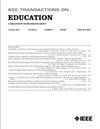顶点设计中问题范围界定过程中脚手架和反思的影响
IF 2
2区 工程技术
Q2 EDUCATION, SCIENTIFIC DISCIPLINES
引用次数: 0
摘要
贡献:本文探讨了在 COVID-19 大流行之前和期间,由行业赞助的工程设计顶点课程中的问题界定。文章采用了行动反思和定量行动研究的方法,展示了大流行如何为以下两方面提供了机会:1)学生如何发展他们的问题范围界定技能;2)教学团队如何设计基于反思的新型干预措施,以支持学生的问题范围界定过程。背景:尽管问题范围界定在工程设计中非常重要,但对工程专业本科生问题范围界定能力的培养,尤其是在 COVID-19 大流行病等危机期间的培养,仍未得到充分研究。虽然人们普遍认为大流行病对高等教育的影响是负面的,但本文提出了不同的观点,认为大流行病可能改善了学生的反思实践。本文通过比较参加顶点实习的三批学生在大流行前(2019 年)、大流行开始时(2020 年)和大流行开始一年后(2021 年)的反思实践,对这一点进行了研究。研究问题在 2020 年和 2021 年,学生的问题范围界定技能如何因大流行病动机干预而发生变化?研究方法:由于针对大流行病设计的干预措施具有反复性,因此采用了定量行动研究方法。范围界定指标来自最终项目报告,并使用非参数统计检验对不同组群进行比较。之所以选择非参数检验,是因为样本量较小,且违反了正态性和方差同质性假设。研究结果增加在行动中反思的机会可提高设计绩效(有细微差别),这强调了向工科学生传授反思性设计实践的重要性,以更好地装备他们解决复杂的设计问题。本文章由计算机程序翻译,如有差异,请以英文原文为准。
The Impact of Scaffolding and Reflection During Problem Scoping in Capstone Design
Contribution: This article explored problem scoping in an industry sponsored engineering design capstone course before and during the COVID-19 pandemic. It employs reflection-in-action and quantitative action research, to demonstrate how the pandemic offered an opportunity for 1) students to develop their problem scoping skills and 2) for the instruction team to design novel reflection-based interventions to support students’ problem scoping process. Background: Despite the importance of problem scoping in engineering design, its development in engineering undergraduates, especially during crises, such as the COVID-19 pandemic, remains understudied. While the pandemic’s impact on higher education is generally perceived to have been negative, this article presents a different perspective, suggesting it may have improved students’ reflective practices. This is examined by comparing three cohorts of students who participated in the capstone prepandemic (2019), at the onset of the pandemic (2020), and a year after the pandemic began (2021). Research Question: How did students’ problem scoping skills change due to pandemic-motivated interventions in 2020 and 2021? Methodology: A quantitative action research approach was utilized due to the iterative nature of the interventions designed in response to the pandemic. Scoping metrics were derived from final project reports and compared across cohorts using nonparametric statistical tests. Nonparametric tests were selected due to small sample sizes and violation of the assumption of normality and homogeneity of variance. Findings: Increasing opportunities for reflection-in-action lead to improved design performance (with nuances) underscoring the importance of teaching reflective design practices to engineering students to better equip for complex design problem-solving.
求助全文
通过发布文献求助,成功后即可免费获取论文全文。
去求助
来源期刊

IEEE Transactions on Education
工程技术-工程:电子与电气
CiteScore
5.80
自引率
7.70%
发文量
90
审稿时长
1 months
期刊介绍:
The IEEE Transactions on Education (ToE) publishes significant and original scholarly contributions to education in electrical and electronics engineering, computer engineering, computer science, and other fields within the scope of interest of IEEE. Contributions must address discovery, integration, and/or application of knowledge in education in these fields. Articles must support contributions and assertions with compelling evidence and provide explicit, transparent descriptions of the processes through which the evidence is collected, analyzed, and interpreted. While characteristics of compelling evidence cannot be described to address every conceivable situation, generally assessment of the work being reported must go beyond student self-report and attitudinal data.
 求助内容:
求助内容: 应助结果提醒方式:
应助结果提醒方式:


